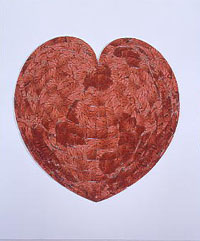

  |
||
 Lingua Geographica, 1996 Pinned photograph, framed 200 x 200 x 10 centimeters (approx. 78.75 x 78.75 x 3.95") Collection of Erika and Robin Congreve |
Born 1962, West Melton, New Zealand; lives in
Canberra, Australia
Lingua Geographica For the last fifteen years, Watson’s works have been about cartography, in particular the way that maps inform our idea of the world. Watson creates works based on early historical projections of the globe. For example, this work uses photographic fragments of a picture of her tongue to create a map of the world in the shape of a heart. This map shape is known as a cordiform projection and was invented by the sixteenth-century German astronomer Johannes Stobern. The representation of the world using imagery of the artist’s tongue, a sensory organ, suggests that maps affect the way we experience the world. Oceanography Asia Society chat with the artist: I am a fourth-generation Pakeha New Zealander – Pakeha is a Maori word for non-Maori from New Zealand so we have a label that has been given to us by the indigenous people. I am interested in this heritage, in how white people came to be Pacific Islanders, in a sense, because that is the history of my ancestors who left Ireland, Scotland, and England - the classic UK mix - and all that is gone. I have no relationship to those places, I do not identify with them. It would of course be nice to go for a visit, but they are not ‘home’ by any means; I am a New Zealander. So I am interested in that process, how this came about. |